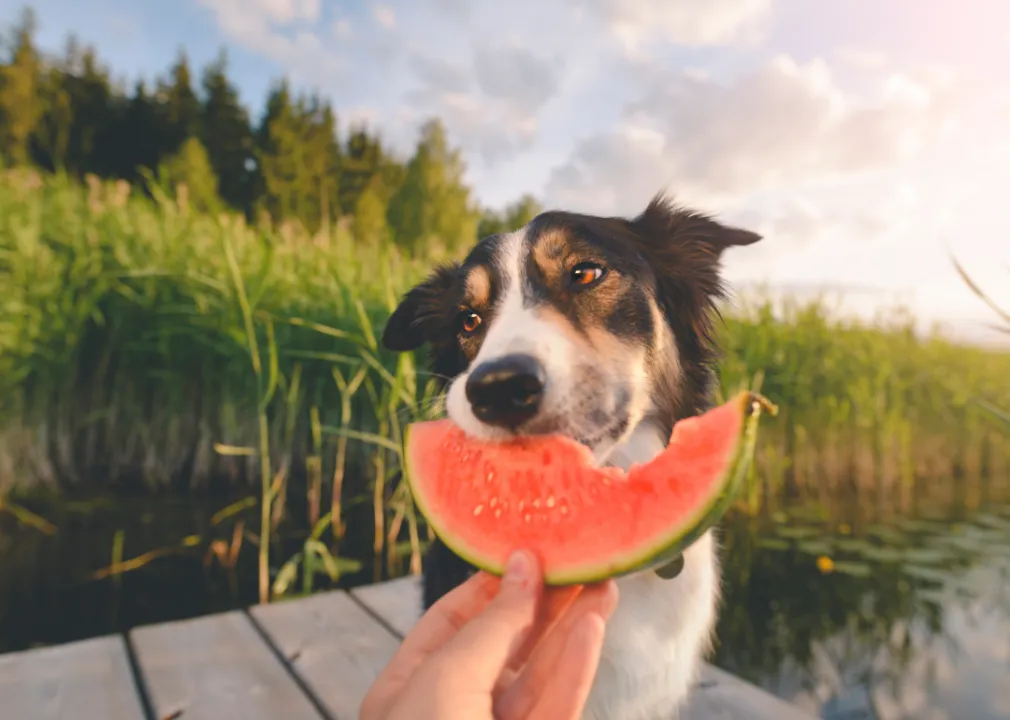Common foods you shouldn't feed your dog and why, according to experts
Pets

Audio By Carbonatix
By Colleen Kilday, Stacker

Common foods you shouldn't feed your dog and why, according to experts
Some dogs will only eat kibble when it is soaked in gravy. Others must be stopped from eating rocks. Whether Fido is a refined diner or a food fiend, it is the owner's responsibility to make sure their foods are safe. Most know not to treat their pup to chocolate, but other dangers lurk in the most innocent-looking ingredients. Apart from over-the-counter medicines, human food constituted the most cases of reported pet toxin exposure in 2022, according to the American Society for the Prevention of Cruelty to Animals.
Ingesting toxic food affects more than just a dog's well-being; it can also make a sizable dent in an owner's pocket. According to a 2023 report from MetLife pet insurance, emergency vet visits for dogs usually cost between $150 and $5,000, depending on the needed services. Ollie consulted with veterinary experts and dove into dog nutrition research to get to the bottom of what is and isn't safe for dogs to eat—and why.
Not all fruits and vegetables are healthy
Fruits and vegetables have a sterling reputation among humans, but not all spell health benefits for canines. The allium family, including onions, garlic, and chives, contain N-propyl disulfide, which damages dogs' red blood cells and leads to anemia. A common addition to human dishes, onions and garlic are sometimes unintentionally given to dogs by their owners as leftovers.
Full of healthy fats, avocado has become a popular addition to human dishes in recent years. But it also contains persin, a fungicidal toxin that causes vomiting, diarrhea, and other serious health problems in dogs.
In 2022, after a 20-year-long mystery, the ASPCA Poison Control Center veterinarians identified tartaric acid as the compound that makes grapes toxic to dogs. This compound is also in sultanas, raisins, tamarind, and cream of tartar.
Peppers containing capsaicin, all except bell peppers, can cause a range of medical issues in dogs, such as vomiting, not to mention irritating their skin and eyes.
Don't go nuts for 'nuts'
Dogs can breathe a woof of relief: Peanut butter is still safe for them to eat. It's a good source of healthy fats, vitamins B and E, as well as protein. Choose peanut butter that is unsalted, low in salt, or made with dogs in mind. Peanut butter should be treated like a treat. Too much can lead to obesity and pancreatitis.
Other nuts and foods that may fall under this category are not so dog-friendly, however, according to the American Kennel Club. While almonds are nontoxic, they are not easily digested. Macadamia nuts are highly toxic to dogs and can cause weakness, overheating, and even depression. The veterinary community is still not quite sure which compound is the culprit. Food containing the compound juglone, including walnuts and pecans, also causes digestive distress.
Skip the sweet nothings
Added to many foods marketed as "diet" or "sugar-free," ingestion of xylitol can "lead to liver failure and hypoglycemia in dogs," veterinarian Dr. Michael Thompson, founder of Pet Food Safety, told Stacker. The sugar substitute may also be listed as "wood sugar," "birch sugar," or "birch bark extract" on ingredient labels. According to the ASPCA Animal Poison Control Center, xylitol gum, along with other human food, was one of the most frequently reported ingested toxic human foods in 2022.
Sugar-free gum is the most common culprit, but veterinarian Dr. Stephanie Shane, who owns Staples Mill Animal Hospital in Woodbridge, Virginia, cautions owners that xylitol also appears in many "sugar-free cookies and even sugar-free peanut butters."
Bone up on dog chews
It may be tempting to offer Fido the wishbone from the Thanksgiving turkey, but cooked bones are prone to splintering and can cause gastrointestinal upset. Instead, Thompson recommends choosing one made specifically for dogs.
When shopping for chew bones or rawhides, which are dog chews made from animal skin, look for products "that come with a label of being preservative-free, chemical-free, and ideally, made in countries with strict safety standards, like the United States or Canada," he said.
Thompson further explained that what constitutes a "safe" bone is relative to the dog's chewing behavior and size.
"You want to choose a size that is large enough to prevent the dog from swallowing it whole, which can lead to choking or gastrointestinal blockages. However, the rawhide also shouldn't be so large that the dog can't handle it comfortably," he said.
On top of choosing an appropriate dog chew, Thompson also suggests purchasing ones that promote dental health: "Many available products are specifically designed to reduce tartar and plaque buildup and freshen breath, along with providing a safe chewing experience."
Get ready, in case of emergencies
Because new foods are frequently introduced into the market, no list of dietary dangers can be fully exhaustive. According to Thompson, this emphasizes the need for pet owners to stay up-to-date on pet nutrition.
"It's vital for dog owners to be aware of these risks to prevent unnecessary health complications and vet visits, reinforcing the importance of feeding pets foods specifically formulated for their dietary needs," he added.
But even the most responsible owners cannot bear witness to everything a dog eats. Owners who catch their dog in the act of eating something dangerous should act quickly but carefully to intervene.
"You have to try to distract them because they are going to want to swallow what you're trying to take as fast as possible," Shane told Stacker.
To encourage them to let go, she suggests offering a trade in the way of a treat or toy. When ingestion is suspected, however, she advises owners to use the ASPCA Animal Poison Control Center hotline at 888-426-4435 as a first line of defense. The hotline is available 24/7, though a consultation fee may apply.
"The center has access to a list of brand names and ingredients in order to determine the amount they may have ingested," she said. "They can also provide a print-out treatment plan to take to the veterinarian."
Using the hotline also enables owners to avoid unnecessary vet visits and identify signs of distress specific to the ingested food. Signs of food poisoning often start with vomiting, salivating, and diarrhea, advancing to tremors, agitation, and drooling. Any severe behavioral changes, like pacing, whining, or lethargy, also warrant attention. Symptoms of food poisoning may manifest hours to days after ingestion, so it is important to monitor any changes in a dog's condition.
Story editing by Carren Jao. Copy editing by Lois Hince.
This story was produced by Ollie (Inc) and was produced and distributed in partnership with Stacker.

























